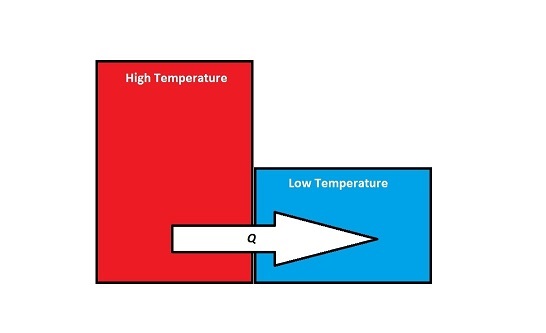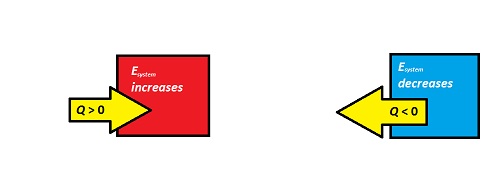Energy Transfer due to a Temperature Difference
This section will be sharing how to calculate energy transfer in systems that are affected by temperature changes. This related to Chapter 7 in the Text Book and Exam 3.
Woong Jun Park
wpark39
Carter Gillon (cgillon3), Fall 2016
The Main Idea
When two objects that have different temperatures come into contact with one another, energy will be transferred from the object with the higher temperature to the object with the lower temperature. Although work is occurring at a microscopic level, since at the point of contact, the individual atoms on the surfaces of the objects are doing work on each other, this energy transfer is not referred to as work, W, because there are no macroscopic forces or displacements. Instead:
- Energy Transfer Due to a Temperature Difference = [math]\displaystyle{ Q }[/math]
Therefore, for an open system, the energy principle is:
- [math]\displaystyle{ ∆E_{system} = Q + W + }[/math] other energy transfers
- Q is used to describe the amount of energy that is exchanged between the system and surroundings when there is a temperature difference between them (microscopic work)
- W is used to describe the energy transfer due to other forces (macroscopic, mechanical work)
- other energy transfers could include matter transfer, mechanical waves, electricity, electromagnetic radiation, etc...
Sign of Q
[math]\displaystyle{ Q }[/math] can be positive or negative depending on the energy change.
If energy is transferred from the system to the surroundings (the system is getting colder), then [math]\displaystyle{ Q }[/math] is negative. If energy is transferred from the surroundings to the system (the system is heating up), then [math]\displaystyle{ Q }[/math] is positive.
The Steady State When a system is described as being in "steady state", that means that the overall energy of the system, [math]\displaystyle{ E_{system} }[/math], does not change despite the other energy transfers occurring in the system. Also, for a system to be at steady state, the energy flow flowing into the system must be doing so at the same rate as the energy flowing out of the system.
A Mathematical Model
The following are mathematical models that you will use in these calculations:
The Energy Principle
- [math]\displaystyle{ ∆E_{system} = Q + W + }[/math] other energy transfers
Calculating Heat Transfer
- [math]\displaystyle{ ∆E_{thermal} = mC(∆T) }[/math]
- [math]\displaystyle{ ∆E_{thermal} }[/math] = Heat Added
- [math]\displaystyle{ m }[/math] = mass
- [math]\displaystyle{ C }[/math] = Specific Heat
- [math]\displaystyle{ ∆T }[/math] = change in Temperature
Calculating the Temperatures of Two Objects in Contact
- [math]\displaystyle{ ∆E_{system} = Q + W + }[/math] other energy transfers
- [math]\displaystyle{ W = 0 }[/math], other = 0, so [math]\displaystyle{ ∆E_{system} = Q = 0 }[/math]
- [math]\displaystyle{ ∆E_{system} = 0 = ∆E_{thermal,1} +∆E_{thermal,2} }[/math]
- [math]\displaystyle{ 0 = mC_1(T_f - T_1) + mC_2(T_f - T_2) }[/math]
A Computational Model
Check this video out for a brief understanding of how Heat & Temperature relate to Physics.
Heat Transfer
Check this video out for a detailed look into the topic.
Relationship between deltaE and Q+W
Examples
Simple
5000 [math]\displaystyle{ J }[/math] of electric energy is put into an electric heater. If the heating element is maintained at a constant temperature throughout this time period, what is [math]\displaystyle{ ∆E_{thermal} }[/math] for the system, and what is [math]\displaystyle{ Q }[/math], the energy transfer between the heater's heating element and the cool air?
Solution: System: heater
Surroundings: air, electric input
[math]\displaystyle{ ∆E_{system} = W + Q }[/math] + other energy inputs
There is no internal energy change since the heater is maintained at a constant temperature, so [math]\displaystyle{ ∆E_{thermal} = ∆E_{system} = 0 }[/math]
[math]\displaystyle{ ∆E_{system} = W + Q }[/math] + other energy inputs
[math]\displaystyle{ 0 = 0 + Q + 5000 J }[/math]
[math]\displaystyle{ Q = -5000 J }[/math]
Middling
You put a thin metal pot containing 3787 [math]\displaystyle{ g }[/math] of room-temperature (20 °C) water on a hot electric stove. You also stir the water vigorously with an electric beater, which does 100 [math]\displaystyle{ J }[/math] of work on the water every second. You observe that after 10 minutes the water starts to boil (100 °C). The specific heat capacity of water is 4.2 [math]\displaystyle{ J(g·C)^{−1} }[/math]. What is the thermal transfer of energy, [math]\displaystyle{ Q }[/math], into the water from the surroundings?
Solution:
[math]\displaystyle{ ∆E_{system} = W_{surr} + Q }[/math]
[math]\displaystyle{ ∆E_{thermal} = W_{surr} + Q }[/math]
[math]\displaystyle{ Q = ∆E_{thermal} - W_{surr} }[/math]
- [math]\displaystyle{ ∆E_{thermal} = mC(∆T) = (3787 g)(4.2 J(g·C)^{−1})(100 - 20 °C) }[/math]
- [math]\displaystyle{ ∆E_{thermal} = 1.272 }[/math] x [math]\displaystyle{ 10^6 J }[/math]
- [math]\displaystyle{ W_{surr} = W*t = (100 J*s^{-1})(10 * 60s) }[/math]
- [math]\displaystyle{ W_{surr} = 6 }[/math] x [math]\displaystyle{ 10^4 J }[/math]
[math]\displaystyle{ Q = ∆E_{thermal} - W_{surr} = 1.272 }[/math] x [math]\displaystyle{ 10^6 J - 6 }[/math] x [math]\displaystyle{ 10^4 J }[/math]
[math]\displaystyle{ Q = 1.212 }[/math] x [math]\displaystyle{ 10^6 J }[/math]
Difficult
You have two cups of coffee. Each cup contains 350 grams of coffee at 93 °C. The specific heat of coffee is 4.2 [math]\displaystyle{ J(g·°C)^{−1} }[/math]. Assume that no energy is transferred between the coffee and the cup.
- A. If you want to bring the coffee down to a temperature of 82 °C, how much cream do you have to add if the cream's initial temperature is 5 °C and it has a specific heat of 3.8 [math]\displaystyle{ J(g·°C)^{−1} }[/math]?
Solution:
1 = the cup of coffee
2 = the cream
need to find the mass of the cream you need to add:
[math]\displaystyle{ ∆E = ∆E_{thermal, 1} + ∆E{thermal, 2} }[/math]
[math]\displaystyle{ m_1C_1(T_f - T_1) + m_2C_2(T_f - T_2) = 0 }[/math]
[math]\displaystyle{ m_2C_2(T_f - T_2) = -m_1C_1(T_f - T_1) }[/math]
[math]\displaystyle{ m_2 = -m_1C_1(T_f - T_1)/C_2(T_f - T_2) = (350 g)(4.2 J(g·°C)^{−1})(82°C - 93 °C) / (3.8 J(g·°C)^{−1})(882°C - 5 °C) }[/math]
[math]\displaystyle{ m_2 = 55.3 g }[/math]
- B. You add 16 grams of sugar (heat capacity of 1.2 [math]\displaystyle{ J(g·°C)^{−1} }[/math] and initial temperature of 20 °C) to the coffee and stir, doing 15 [math]\displaystyle{ J }[/math] of work. When the liquid stops moving, what is the final temperature of the coffee?
Solution:
[math]\displaystyle{ ∆E = ∆E_{thermal, c} + ∆E{thermal, s} = W }[/math]
[math]\displaystyle{ m_cC_c(T_f - T_c) + m_sC_s(T_f - T_s) = W }[/math]
[math]\displaystyle{ m_cC_cT_f - m_cC_cT_c + m_sC_sT_f - m_sC_sT_s = W }[/math]
[math]\displaystyle{ T_f(m_cC_c + m_sC_s) = W + m_cC_cT_c + m_sC_sT_s }[/math]
[math]\displaystyle{ T_f = W + m_cC_cT_c + m_sC_sT_s / (m_cC_c + m_sC_s) = (15 + (350)(4.2)(93) + (16)(1.2)(20)) / ((350)(4.2) + (16)(1.2)) }[/math]
[math]\displaystyle{ T_f = 92.07 °C }[/math]
- C. After letting the coffee sit for a long time, the coffee has reached thermal equilibrium with the air and is at 20 °C. Taking the coffee as the system, what was the thermal transfer of energy, [math]\displaystyle{ Q }[/math], between the system and surroundings?
Solution: [math]\displaystyle{ ∆E = mC∆T = Q }[/math]
[math]\displaystyle{ Q = mC(T_f - T_i) = (350 g)(4.2 J(g·°C)^{−1})(20 °C - 93°C) }[/math]
[math]\displaystyle{ Q = -107310 J }[/math]
Connectedness
Interest
I am a chemical and biomolecular engineering major, so energy and heat transfer is one of the most fundamental principles behind reactor process design. Having a solid understanding of this topic will be very beneficial in future ChE courses.
Major Connection
As a chemical engineering major, I will see this topic in nearly every course that I will take. The concept of [math]\displaystyle{ Q = mC∆T }[/math] was introduced to us in our basic chemistry classes, we take two courses on thermodymanics, which heavily emphasize calculating the changes in thermal energy, and we will continue to see this topic in later courses such as kinetics, transport, and reactor design.
Industrial Application
Energy transfer due to a temperature difference is the key principle that makes heat exchangers work. Heat exchangers are used in many chemical process industries in order to cool down a flow stream, which is essential for regulating temperatures in chemical processes to ensure that the flow streams do not get too hot, which could cause serious damage. For a co-current heat exchanger, a hot stream enters a tube at a high temperature, and a cold stream enters a jacket surrounding the inner tube at a much lower temperature. As the two fluids travel down the tube, thermal energy is transferred between the two streams, causing the hot stream to decrease in temperature and the cold stream to increase in temperature. The cooled down hot stream can now move to the next step in the chemical process, and the heated up cold stream can either be used somewhere else in the process, or discarded. Below is a diagram of a co-current heat exchanger.
Using the principle of energy transfer due to a temperature difference, you can write a differential equation to describe the change in temperature of stream 1 as a function of length, which comes out to be the following when simplified:
[math]\displaystyle{ (δT_1)/(δx) (hA_s)/(q_1ρ_1C_p_1) (T_1 - T_2) }[/math]
Where:
- [math]\displaystyle{ A_s }[/math] = surface area
- [math]\displaystyle{ q }[/math] = flow rate
- [math]\displaystyle{ ρ }[/math] = fluid density
- [math]\displaystyle{ C_p }[/math] = heat capacity
History
The history of heat and work can be dated back to 1789 when the French scientist Antoine Lavoisier created a new theory - the phlogiston theory on Chemistry that basically negated all previous findings of combustion. He gave heat a meaning and definition that led to the interpretation of heat that is accepted today.
The modern interpretation is what we hold true in the example questions that we used earlier Q = mCdeltatT.
In 1798, Benjamin Thompson - minister for war and police in the German state of Bavaria - wanted to figure out where all the heat from the cannons were coming from. He observed that the surroundings of the cannon got hotter and not colder. He hypothesized that some of the mechanical work done on the cannon was converted to heat.
In 1849, English physicist James Prescott Joule published his work and findings on the conversion of work to heat that Thompson started. He formulated work equivalent of heat. 1 newton meter of work = 0.241 calories of heat.
In 1850, German physicist Clausius published his works on how conserved quantity is neither heat nor work, but a combination of both. He named this Energy and that is where we get the macroscopic equation deltaE = Q - W.
See also
Relevant material and additional reading can be looked into the history of Joule and the laws of thermodynamics.
Further reading
Specific Heat: Britannica
Dependence of Heat Capacity on Thermal History: Nature Publishing Group
Environmental Research Web | Uneven Climate Change Due to Atmospheric Heat Capacity
External links
USGS Water Science School
Science Direct | Determination of specific heat capacity by transient plane source
Heat Transfer
Relationship between deltaE and Q+W
References
"A Brief History of Heat and Work." A Brief History of Heat and Work. N.p., n.d. Web. 10 Nov. 2015.\
"Application of Specific Heat Capacity" : Application of Specific Heat Capacity. N.p., n.d. Web. 10 Nov. 2015.
"CHAPTER 4: HEAT." : 4.2 Specific Heat Capacity. N.p., n.d. Web. 10 Nov. 2015.
Division of Building Technology, Chalmers University of Technology, Gothenburg SE-412 96, Sweden Received 23 August 2013, Revised 3 September 2013, Accepted 10 September 2013, Available online 22 October 2013
"Re: What Are Some Practical Uses of Determining the Specific Heat of a Metal?" Re: What Are Some Practical Uses of Determining the Specific Heat of a Metal? N.p., n.d. Web. 10 Nov. 2015.


